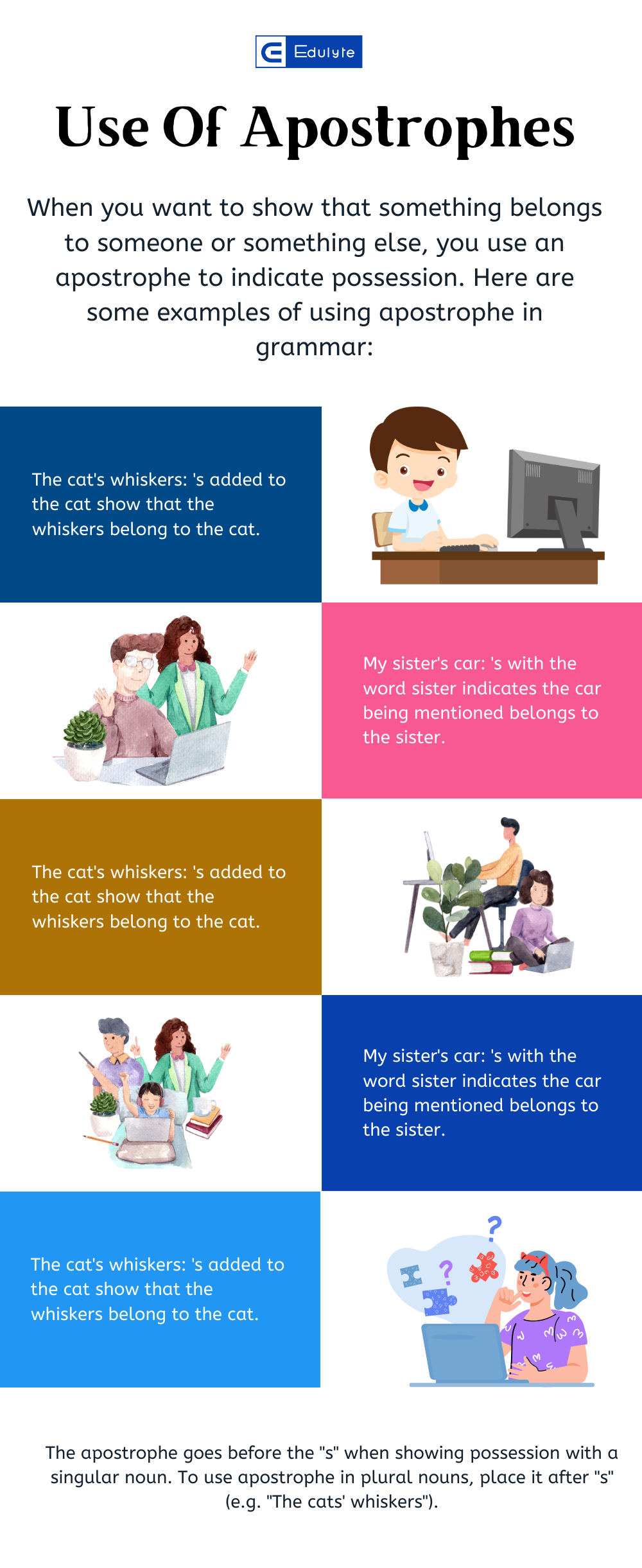
Learn English
Apostrophe
Phonetics:
əˈpɒstrəfi
Pronunciation:
Apostrophe: The Punctuation Mark that Makes a Big Difference
Comprehensive Definition, Description, Examples & Rules
Apostrophes are a fascinating part of English punctuation. Despite being tiny, an apostrophe can challenge your English language skills. Edulyte’s English trainers have created an informative resource covering all the vital aspects: what is an apostrophe, when to use an apostrophe, its examples and how to use an apostrophe.
What Is An Apostrophe: definition, examples and importance
An apostrophe is a punctuation mark resembling a tiny or floating comma. It is represented by a small superscripted mark (‘) placed above the text’s baseline.
It is used to indicate possession, contraction, or to show that a letter has been left out of a word.
Apostrophes play an essential role in the English language as they help to clarify meaning and avoid confusion. By indicating possession, they show who owns what, and by indicating contractions, they help to make writing more concise and readable.
Apostrophe examples:
- I can’t come for dinner today.
- Tony Stark’s house was full of gadgets.
Importance Of Apostrophes In Writing
A good grasp of apostrophes is essential for effective writing. Misusing apostrophes can lead to grammatical errors, confusion and make your writing appear unprofessional. On the other hand, using apostrophes correctly can boost the coherence and clarity of your writing.
Purpose Of An Apostrophe
The use of an apostrophe is necessary in written communication. The primary purpose of an apostrophe is to clarify meaning in written communication.
It does this by indicating possession (e.g., “Samantha’s book”), indicating contractions (e.g., “I’m” instead of “I am”), and showing that a letter has been omitted (e.g., “can’t” instead of “cannot”).
When To Use Apostrophes: use for contractions and possession with examples
Ah, the humble apostrophe. So small, yet so powerful. Knowing when to use this little punctuation mark can be the difference between clear and effective writing and a confusing mess. So let’s take a closer look at how to use apostrophes and when to use apostrophes. They have two common uses: contractions and possession.
Use Of Apostrophes For Contractions
Many of us might have misspelt apostrophe as apostophe while googling its use. It just shows that its usage is more important than its spelling. Apostrophes make writing and speaking much more natural and conversational. They are heavily employed while writing contractions.
So what exactly are contractions? They are shortened forms of words created by combining two words and replacing one or more letters with an apostrophe. Contractions are a great way to add personality and style to your writing.
Here are some common examples of how to use an apostrophe in case of contractions :
Words | Contractions |
I am | I’m |
You are | You’re |
She is / He is | She’s / He’s |
They have | They’ve |
Will not | Won’t |
Cannot | Can’t |
They will | They’ll |
Are not | Aren’t |
Did not | Didn’t |
Use Of Apostrophes For Possession
When you want to show that something belongs to someone or something else, you use an apostrophe to indicate possession. Here are some examples of using apostrophe in grammar:
- The cat’s whiskers: ‘s added to the cat show that the whiskers belong to the cat.
- My sister’s car: ‘s with the word sister indicates the car being mentioned belongs to the sister.
- The company’s profits: ‘s added to the word company means the profits belong to the company
- The book’s cover: ‘s added to the book suggests the cover being mentioned belongs to the book.
- The children’s toys: ‘s added to the word children means the toys being mentioned belong to the children.
The apostrophe goes before the “s” when showing possession with a singular noun. To use apostrophe in plural nouns, place it after “s” (e.g. “The cats’ whiskers”).
How To Use Apostrophes Correctly: guidelines for their use and common mistakes to avoid
Apostrophes – small, yet mighty. These little punctuation marks can make a big difference in your writing . To help you navigate the world of apostrophes, let’s look at some guidelines for using them correctly.
Guidelines for Using Apostrophes Correctly:
- Use an apostrophe to indicate possession (e.g. “John’s bike”).
- Use an apostrophe and “s” to indicate possession with singular nouns (e.g. “The dog’s tail”).
- Use an apostrophe after the “s” for plural nouns that end in “s” to indicate possession (e.g. “The girls’ room”).
- Use an apostrophe before the “s” for plural nouns that do not end in “s” (e.g. “The children’s toys”).
- Use an apostrophe to indicate contractions (e.g. “Don’t” for “Do not”).
- Do not use an apostrophe to indicate plurals (e.g. “I have two cats, not two cat’s”).
Common Mistakes to Avoid When Using Apostrophes
When to use an apostrophe is closely related to how to use an apostrophe. Understanding the common mistakes made when using apostrophes gives you more confidence in handling them.
- Confusing “its” and “it’s”. “It’s” is a contraction for “it is” or “it has”, while “its” indicates possession (e.g. “The cat licked its paw”).
- Adding an apostrophe before the “s” for plurals (e.g. “I have two apple’s”).
- Using an apostrophe to indicate possession with a pronoun (e.g. “Your’s” instead of “Yours”).
- Forgetting to use an apostrophe to indicate possession (e.g. “The cats toys” instead of “The cat’s toys”).
- Placing the apostrophe in the wrong position (e.g. “The cats’ toy’s”).
Additional Tips And Tricks For Using Apostrophes
Congratulations, you’ve mastered the basics of using apostrophes correctly! But before you close the book on this little punctuation mark, there are still more tips and tricks to learn.
For example, some specific rules exist for using apostrophes with words ending in “s”. Also, apostrophes find their use in many other situations too.
Specific rules for using Apostrophes with words ending in “s”
One of the trickiest things about using apostrophes correctly is knowing where to put them when dealing with words that already end in “s”. Here are some guidelines to follow:
- For singular nouns that end in “s”, use an apostrophe and “s” to indicate possession (e.g. “The boss’s office”).
- For plural nouns that end in “s”, use an apostrophe after the “s” to indicate possession (e.g. “The boys’ toys”).
- For nouns that are both singular and plural (e.g. “species”), use an apostrophe and “s” to indicate possession (e.g. “The species’s habitat”).
Other situations in which Apostrophes are used
While we’ve already covered the primary uses of apostrophes (contractions and possession), there are a few different situations in which they may be used:
- Pluralising acronyms and abbreviations: When you need to make an acronym or abbreviation plural, add an apostrophe and “s” (e.g. “The CEO gave a speech at the AGMs’ annual meeting”).
- Showing time or year: Years get mentioned in shorter forms by using apostrophes.When you omit one or more words from a quotation, use an apostrophe to show the missing letters (e.g. ’99 -1999, ’03 – 2003)
Apostrophes find their use while writing time for time (e.g. 1500 hours – 3 o’clock, 6 a.m. – 6 o’clock) - Indicating slang words: Sometimes writers use apostrophes to indicate non-standard spellings or slang words (e.g. Jeff kept walkin’ and talkin”).

Transform Your English Skills
Free sign-up for a personalised dashboard, learning tools, and unlimited possibilities!
Sign up Now
Key Takeaways
- Apostrophes indicate possession or omitted letters in a contraction.
- To make possessive nouns, add an apostrophe (‘) and an “s” at the noun’s end.
- Apostrophes cannot be used to make plurals.
- Apostrophes are used with proper nouns ending in “s” to show possession by adding an apostrophe and another “s”.
- When using a pronoun as a possessive adjective, no apostrophe is needed.
- Apostrophes in contractions replace letters that have been omitted.
- Common mistakes include using apostrophes to make words plural and not using them to show possession.
- It’s important to carefully proofread and double-check your use of apostrophes to ensure your writing is grammatically correct.
Quiz
Question comes here
Frequently Asked Questions
You do not pluralise words with an apostrophe. Apostrophes are used for contractions or to indicate possession, but they are not used to make words plural. Instead, to make a word plural, add “s” or “es” to the end of the word, depending on its spelling. For example, “dog” becomes “dogs”, while “bus” becomes “buses”.
An apostrophe in contractions indicates that one or more letters have been omitted. The apostrophe gets placed where the missing letter(s) would have been in the original word. For example:
- “Can’t” is a contraction of “cannot”, with the “n” and “o” omitted. You find the apostrophe in place of the missing letters. The contraction for cannot is “can’t”.
- “I’m” is a contraction of “I am”, with the “a” omitted. You find the apostrophe in place of the missing letter, so it becomes “I’m”.
- “Don’t” is a contraction of “do not”, with the “o” omitted. You will find the apostrophe in place of the missing letter so it becomes “don’t”.
When it comes to using apostrophes with names ending in “s”, there are a few different rules to follow depending on the situation:
- For singular nouns or names that end in “s”, add an apostrophe and “s” to indicate possession. For example, “James’s book” or “the boss’s office”.
- For plural nouns or names that end in “s”, you must place an apostrophe after the “s” to indicate possession. For example, “the Joneses’ car” or “the students’ project”
- For names or nouns that are both singular and plural (e.g. “species” or “deer”), add an apostrophe and “s” to indicate possession. For example, “the species’ habitat” or “the deer’s tracks”.
No, you cannot use an apostrophe with possessive pronouns. Possessive pronouns already indicate ownership or possession, so adding an apostrophe would be redundant and incorrect.
Here are some examples of possessive pronouns:
- Mine
- Yours
- His
- Hers
- Its
- Ours
- Theirs
Instead of using an apostrophe, you can use the possessive pronoun to show ownership. For example: “The book is hers” or “The backpack is theirs”.
It’s important to note that some pronouns, like “who” and “whom”, don’t possess a possessive form.
Apostrophes (‘)and quotation marks (“, “)are two different punctuation marks that serve different purposes in writing.
An apostrophe is a punctuation mark indicating possession or that one or more letters have been omitted in a contraction. For example, “John’s car” uses an apostrophe to show that the car belongs to John, while “can’t” uses an apostrophe to indicate that the letters “n” and “o” have been omitted from “cannot”.
Quotation marks enclose direct speech, dialogue, or a direct quotation. For example, “She said, ‘I’m tired'” uses quotation marks to indicate that the words “I’m tired” are the exact words the person spoke.
Possessive adjectives already indicate possession, so you don’t need to use an apostrophe with them.
Here are some examples of possessive adjectives:
- My
- Your
- His
- Her
- Its
- Our
- Their
For example, instead of saying, “John’s car is blue”, you could say, “His car is blue”. In this sentence, “his” is a possessive adjective that indicates ownership or possession, so there’s no need for an apostrophe.
When using an apostrophe with compound nouns, the placement depends on whether the compound noun is being used as possessive.
- If the compound noun is not being used as a possessive, add an “s” to the end of the noun. For example, “coffee cup” becomes “coffee cups”, and “book club” becomes “book clubs”.
- If the compound noun is being used as a possessive, add an apostrophe and an “s” to the end of the entire compound noun. For example, “the car belonging to John and Sarah” becomes “John and Sarah’s car”. Similarly, “the meeting of the board of directors” becomes “the board of directors’ meeting”.
Here are some common mistakes people make when using apostrophes:
- Using an apostrophe to make a word plural. Apostrophes should not be used to create a plural unless the word is an abbreviation. For example, “CDs” and “the 1990s” use apostrophes to indicate plurality, but “apple’s” and “banana’s” are incorrect.
- Confusing “its” and “it’s”. “Its” is a possessive pronoun, while “it’s” is a contraction of “it is”. For example, “The dog wagged its tail” uses “its” to indicate that the tail belongs to the dog, while “It’s a beautiful day” uses “it’s” to mean “it is”.
- Placing the apostrophe in the wrong place in a possessive noun. For example, “the dog’s tail” uses an apostrophe correctly to show that the tail belongs to the dog, while “the dogs’ tails” implies that the tails belong to multiple dogs.
- Using apostrophes with possessive pronouns. As mentioned earlier, possessive pronouns like “yours”, “mine”, and “theirs” do not require apostrophes, as they already indicate possession.
- Not using an apostrophe in a contraction. For example, “cant” instead of “can’t” or “ill” instead of “I’ll” are incorrect and miss the apostrophe that indicates that letters have been omitted.
An apostrophe is used in the English language for two primary purposes:
- To indicate possession: An apostrophe shows that something belongs to or is associated with someone or something. For example, “the dog’s tail” suggests that the tail belongs to the dog.
- To indicate contractions: An apostrophe also shows that letters have been omitted in a contraction. For example, “don’t” is a contraction of “do not”, and the apostrophe indicates that the “o” has been omitted.
In addition to these two main uses, apostrophes are also used in some other situations, such as to indicate the plural of letters, numbers, and abbreviations (e.g. “the 1990s”, “Mind your p’s and q’s”), and to clarify the meaning of certain words (e.g. “he’ll” vs “hell”). However, these additional uses are less common than using an apostrophe for possession or contractions.
To help you test your knowledge of apostrophes, Edulyte has shared its resource worksheet. Attempt it to determine your grasp over the concept. All the best!


